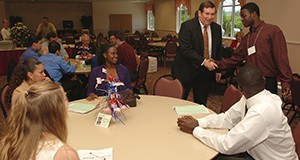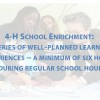 Developing a sense of belonging is one of the Essential Elements of a positive youth development experience. Creating an inclusive environment in your 4-H club programs and activities can help you achieve this goal. Providing many forms of recognition for all, not just for those who excel in competition with other youth, also supports this sense of belonging. This 5-page fact sheet discusses recognition of participation, progress toward goals, standards of excellence, peer competition, and cooperation in the context of 4-H Clubs. Written by Georgene Bender, Tracy Tesdall, and Judith Levings, and published by the UF Department of 4-H Youth Development, November 2015.
Developing a sense of belonging is one of the Essential Elements of a positive youth development experience. Creating an inclusive environment in your 4-H club programs and activities can help you achieve this goal. Providing many forms of recognition for all, not just for those who excel in competition with other youth, also supports this sense of belonging. This 5-page fact sheet discusses recognition of participation, progress toward goals, standards of excellence, peer competition, and cooperation in the context of 4-H Clubs. Written by Georgene Bender, Tracy Tesdall, and Judith Levings, and published by the UF Department of 4-H Youth Development, November 2015.
http://edis.ifas.ufl.edu/4h370
Tag: Tracy Tesdall
4-H School Enrichment: A Guide for 4-H Faculty and Staff
 School Enrichment is a partnership between the University of Florida/IFAS Extension Service and a school district to provide educational content in various subject areas. Extension values its relationship with the schools and welcomes the opportunity to provide research-based curricula for classroom use. This 8-page fact sheet includes a desciption of 4-H School Enrichment and its benefits, procedures for starting and scheduling a program, resources and guidelines, and tips for promoting involvement to other 4-H programs. Adapted for use in Florida by Tracy A. Tesdall and published by the UF Department of 4-H Youth Development, April 2015.
School Enrichment is a partnership between the University of Florida/IFAS Extension Service and a school district to provide educational content in various subject areas. Extension values its relationship with the schools and welcomes the opportunity to provide research-based curricula for classroom use. This 8-page fact sheet includes a desciption of 4-H School Enrichment and its benefits, procedures for starting and scheduling a program, resources and guidelines, and tips for promoting involvement to other 4-H programs. Adapted for use in Florida by Tracy A. Tesdall and published by the UF Department of 4-H Youth Development, April 2015.
http://edis.ifas.ufl.edu/4h324
The Extension Services-237 Report: Everything You Need to Know
 The Extension Services-237 (ES-237) is a report of the Cooperative Extension Service that consists of enrollment statistics for youth ages 5–18 participating in Extension youth programs and the volunteers providing service to these programs. Since partial funding for Extension youth programs is received through the USDA, each county and state must report each year on the race, gender, grade, and residence of each participant in these programs. In Florida, the report is completed by each UF/IFAS county Extension office each year using 4HOnline, then submitted to Florida 4-H state headquarters where they are compiled into a single state report and submitted to the National Institute of Food and Agriculture (NIFA) at the United States Department of Agriculture (USDA). This 6-page fact sheet was written by Ben Knowles and Tracy A. Tesdall, and published by the UF Department of 4-H Youth Development, October 2014.
The Extension Services-237 (ES-237) is a report of the Cooperative Extension Service that consists of enrollment statistics for youth ages 5–18 participating in Extension youth programs and the volunteers providing service to these programs. Since partial funding for Extension youth programs is received through the USDA, each county and state must report each year on the race, gender, grade, and residence of each participant in these programs. In Florida, the report is completed by each UF/IFAS county Extension office each year using 4HOnline, then submitted to Florida 4-H state headquarters where they are compiled into a single state report and submitted to the National Institute of Food and Agriculture (NIFA) at the United States Department of Agriculture (USDA). This 6-page fact sheet was written by Ben Knowles and Tracy A. Tesdall, and published by the UF Department of 4-H Youth Development, October 2014.
http://edis.ifas.ufl.edu/4h345
A Guide to the Florida 4-H Council
 The 4-H Program utilizes many tools or methods to provide educational experiences for youth. The 4-H Council (or other relevant named group) at county, district, and state levels is one of these tools. A Council is an elected representative group of 4-H members who meet, discuss, plan, and assist in carrying out 4-H programs and activities in the interest of the total membership. The Council provides a link between local clubs or groups and County 4-H Programs, between County Programs and District 4-H Programs, and between District Programs and State 4-H Programs. This 11-page guide was written by Stacey E. Ellison, Tracy Tesdall, J. A. Rutledge, Joy C. Jordan, and Wendi Armstrong, and published by the UF Department of 4-H Youth Development, December 2014.
The 4-H Program utilizes many tools or methods to provide educational experiences for youth. The 4-H Council (or other relevant named group) at county, district, and state levels is one of these tools. A Council is an elected representative group of 4-H members who meet, discuss, plan, and assist in carrying out 4-H programs and activities in the interest of the total membership. The Council provides a link between local clubs or groups and County 4-H Programs, between County Programs and District 4-H Programs, and between District Programs and State 4-H Programs. This 11-page guide was written by Stacey E. Ellison, Tracy Tesdall, J. A. Rutledge, Joy C. Jordan, and Wendi Armstrong, and published by the UF Department of 4-H Youth Development, December 2014.
http://edis.ifas.ufl.edu/4h315
4-H Pizza Garden: An Agricultural Adventure
 This curriculum was designed for educators to teach young people about where their food originates by using something children love to eat…PIZZA! According to a recent Gallup poll, kids between the ages of 3 and 11 prefer pizza to all other foods for lunch and dinner. Americans eat about 100 acres of pizza each day, or 350 slices per second!This 4-H in the Classroom project, originating in Pinellas County, Florida, was designed for grades 3–5, but can be adapted to serve other grade levels. The lessons cover subject areas such as mathematics, social studies, language arts, and science. It has been used in Pinellas County very successfully since 2000 by the 4-H Program in collaboration with their Florida Ag in the Classroom Initiative. This 89-page fact sheet was written by Janet Golden, Joy Jordan, Nan Jensen, Betty Lipe, Millie Ferrer, Anne Fugate, Erin Karkheck, Linda Bobroff, Karla Shelnutt, and Tracy Tesdall, and published by the UF Department of 4-H Youth Development, November 2014.
This curriculum was designed for educators to teach young people about where their food originates by using something children love to eat…PIZZA! According to a recent Gallup poll, kids between the ages of 3 and 11 prefer pizza to all other foods for lunch and dinner. Americans eat about 100 acres of pizza each day, or 350 slices per second!This 4-H in the Classroom project, originating in Pinellas County, Florida, was designed for grades 3–5, but can be adapted to serve other grade levels. The lessons cover subject areas such as mathematics, social studies, language arts, and science. It has been used in Pinellas County very successfully since 2000 by the 4-H Program in collaboration with their Florida Ag in the Classroom Initiative. This 89-page fact sheet was written by Janet Golden, Joy Jordan, Nan Jensen, Betty Lipe, Millie Ferrer, Anne Fugate, Erin Karkheck, Linda Bobroff, Karla Shelnutt, and Tracy Tesdall, and published by the UF Department of 4-H Youth Development, November 2014.
http://edis.ifas.ufl.edu/4h356
4-H School Enrichment: A Guide for 4-H Faculty and Staff (4H324)
 A partnership with the schools extends the 4‑H program to more youth through a unique delivery mode. Since School Enrichment may be a new experience for some Extension agents, this 8-page guide presents some strategies for developing a partnership with the schools and for programming. Written by Tracy A. Tesdall and published by the 4-H Youth Development Program, September 2012.
A partnership with the schools extends the 4‑H program to more youth through a unique delivery mode. Since School Enrichment may be a new experience for some Extension agents, this 8-page guide presents some strategies for developing a partnership with the schools and for programming. Written by Tracy A. Tesdall and published by the 4-H Youth Development Program, September 2012.
http://edis.ifas.ufl.edu/4h324
Florida 4-H Cloverbuds: A Programming Guide for Staff and Volunteers (4HGCL23/4H317)
4-H Cloverbuds, age 5-7, have unique learning characteristics and developmental needs that are different from older members. As a result, the 4-H Cloverbuds program is designed with specific educational objectives and program policies focused on the 5–7 year-old child. This 36-page fact sheet was written by Joy C. Jordan, Kate Fogarty, Tracy Tesdall, and Renée Gore, and published by the UF Department of 4-H Youth Development, March 2011.
http://edis.ifas.ufl.edu/4h317
A Guide to the Florida 4-H Council (4HGCM12/4H315)
A 4-H Council at county, district, and state levels is one of the tools the 4-H Program uses to provide educational experiences for youth. A Council is an elected representative group of 4-H members who meet, discuss, plan, and assist in carrying out 4-H programs and activities in the interest of the total membership. The Council provides links between local clubs or groups and County 4-H Programs, County Programs and District 4-H Programs, and District Programs and State 4-H Programs.
This revised 20-page guide, written by J.A. Rutledge, Joy C. Jordan, Wendi Armstrong, and Tracy Tesdall, includes the consitution, bylaws, annual calendar, and 4-H pledge. Published by the UF Department of 4-H Youth Development, January 2011.
http://edis.ifas.ufl.edu/4h315